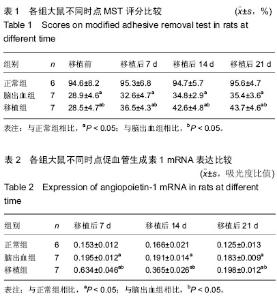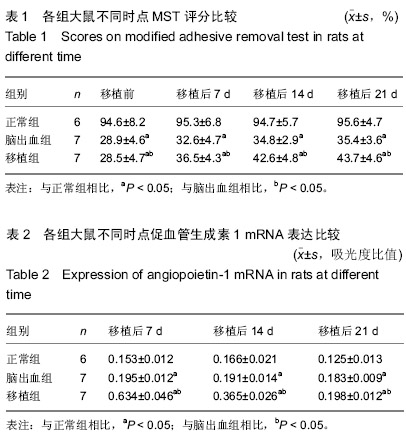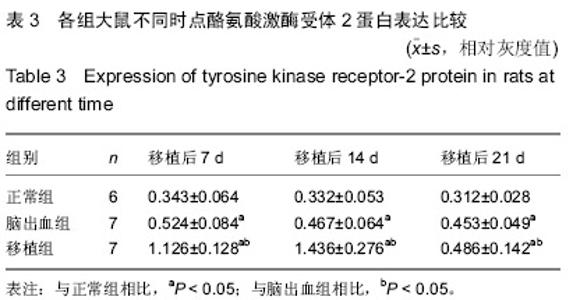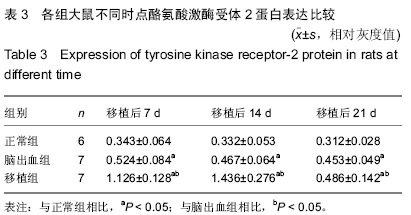| [1] Zacharek A, Chen J, Cui X,et al. Angiopoietin1/Tie2 and VEGF/Flk1 induced by MSC treatment amplifies angiogenesis and vascular stabilization after stroke. J Cereb Blood Flow Metab. 2007;27(10):1684-1691.
[2] Morgenstern LB, Hemphill JC 3rd, Anderson C, et al. Guidelines for the management of spontaneous intracerebral hemorrhage: a guideline for healthcare professionals from the American Heart Association/American Stroke Association. Stroke. 2010;41(9):2108-2129.
[3] Komotar RJ, Kim GH, Sughrue ME, et al. Neurologic assessment of somatosensory dysfunction following an experimental rodent model of cerebral ischemia. Nat Protoc. 2007;2(10):2345-2347.
[4] Butcher K, Jeerakathil T, Emery D, et al. The Intracerebral Haemorrhage Acutely Decreasing Arterial Pressure Trial: ICH ADAPT. Int J Stroke. 2010;5(3):227-233.
[5] Ren JC,Zhou XY,Wang J,et al.Poxue Huayu and Tianjing Busui Decoction for cerebral hemorrhage.Neural Regen Res. 2013;8(22): 2039-2049.
[6] Bühnemann C, Scholz A, Bernreuther C, et al. Neuronal differentiation of transplanted embryonic stem cell-derived precursors in stroke lesions of adult rats. Brain. 2006;129 (Pt 12):3238-3248.
[7] Tu CJ, Liu WG, Dong XQ, et al. Association of interleukin-11 with mortality in patients with spontaneous basal ganglia haemorrhage. J Int Med Res. 2011;39(4):1265-1274.
[8] 杨东波,李永利,杨立庄,等.神经干细胞移植治疗大鼠脑缺血再灌注损伤实验研究[J].中华神经外科疾病研究杂志,2006,5(5):434-437.
[9] Yamamoto A, Takahashi H, Kojima Y, et al. Downregulation of angiopoietin-1 and Tie2 in chronic hypoxic pulmonary hypertension. Respiration. 2008;75(3):328-338.
[10] Moniche F, Gonzalez A, Gonzalez-Marcos JR, et al. Intra-arterial bone marrow mononuclear cells in ischemic stroke: a pilot clinical trial. Stroke. 2012;43(8):2242-2244.
[11] 陈志聪,刘伟,张颖冬.脑缺血恢复期骨髓间充质干细胞移植对神经功能和促血管生成素-1、2及其受体表达的影响[J].临床神经病学杂志,2010,23(4):284-287.
[12] 李慧,顾健,林传明,等.脐带间充质干细胞对 CIA 大鼠炎症因子的干预[J].中国组织工程研究与临床康复,2011,15(36):6701- 6704.
[13] Nakajima H, Uchida K, Guerrero AR, et al. Transplantation of mesenchymal stem cells promotes an alternative pathway of macrophage activation and functional recovery after spinal cord injury. J Neurotrauma. 2012;29(8):1614-1625.
[14] Sasaki M, Radtke C, Tan AM, et al. BDNF-hypersecreting human mesenchymal stem cells promote functional recovery, axonal sprouting, and protection of corticospinal neurons after spinal cord injury. J Neurosci. 2009;29(47):14932-14941.
[15] Kahn J. Stem cells show mixed results in MI patients. J Interv Cardiol. 2006;19(4):297-301.
[16] Chen CP, Lee YJ, Chiu ST, et al. The application of stem cells in the treatment of ischemic diseases. Histol Histopathol. 2006;21(11):1209-1216.
[17] Lee HJ, Kim KS, Kim EJ, et al. Brain transplantation of immortalized human neural stem cells promotes functional recovery in mouse intracerebral hemorrhage stroke model. Stem Cells. 2007;25(5):1204-1212.
[18] Yamamoto A, Takahashi H, Kojima Y, et al. Downregulation of angiopoietin-1 and Tie2 in chronic hypoxic pulmonary hypertension. Respiration. 2008;75(3):328-338.
[19] Zhang H, Huang Z, Xu Y, et al. Differentiation and neurological benefit of the mesenchymal stem cells transplanted into the rat brain following intracerebral hemorrhage. Neurol Res. 2006;28(1):104-112.
[20] Jeong SW, Chu K, Jung KH, et al. Human neural stem cell transplantation promotes functional recovery in rats with experimental intracerebral hemorrhage. Stroke. 2003;34(9): 2258-2263.
[21] 徐竞,杨光明,李涛,等.细胞外信号调节激酶介导血管生成素-1、2对休克血管低反应性的调节[J].中华实验外科杂志,2012,29(7): 1290-1292.
[22] 王国峰,刘伯芹,孙顺昌,等. 脑缺血预处理对脑缺血大鼠血管生成素-1及其受体Tie-2 mRNA表达的影响[J].国际脑血管病杂志, 2012,20(1):24-29.
[23] Koh GY. Orchestral actions of angiopoietin-1 in vascular regeneration. Trends Mol Med. 2013;19(1):31-39.
[24] Hansen TM, Moss AJ, Brindle NP. Vascular endothelial growth factor and angiopoietins in neurovascular regeneration and protection following stroke. Curr Neurovasc Res. 2008;5(4):236-245.
[25] Zimmermann S, Voss M, Kaiser S, et al. Lack of telomerase activity in human mesenchymal stem cells. Leukemia. 2003; 17(6):1146-1149.
[26] Lee ST, Chu K, Jung KH, et al. Anti-inflammatory mechanism of intravascular neural stem cell transplantation in haemorrhagic stroke. Brain. 2008;131(Pt 3):616-629.
[27] 孙顺昌,王国峰.血管生成素-1在缺血性脑损伤中的作用研究进展[J].国际神经病学神经外科学杂志,2011,38(5):496-500. |



